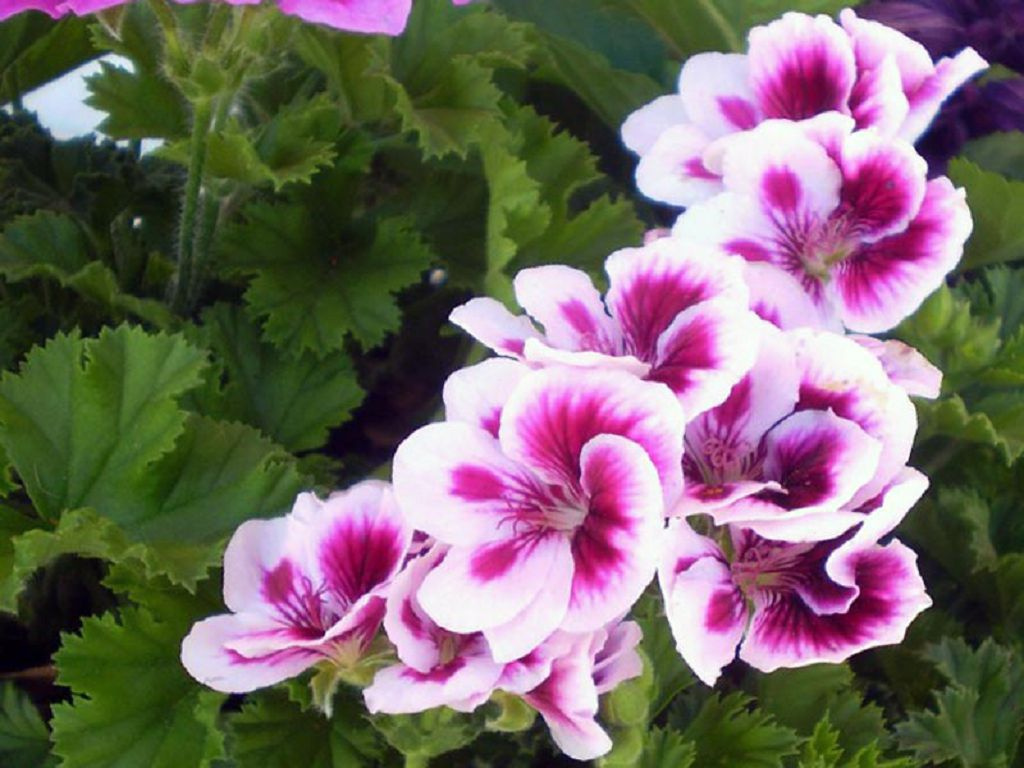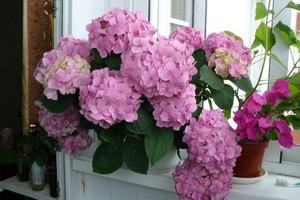Pelargonium (Geranium) is a semi-shrub or herbaceous flower that belongs to the geranium group. More than 400 varieties of it are found in all parts of the world. It got its name from the Greeks because of the shape of the fruit, which looks like a crane's beak, and in Germany this flower is called "stork's nose".
Pelargonium was brought to Europe from Africa in the 17th century. The peculiar smell and decorativeness of the plant won her great popularity in aristocratic circles, and after that geraniums began to appear in the gardens of other classes. Pelargonium came to our country in the 18th century, and since that time it has become the most beloved flower of almost all gardeners. This is due to its beautiful flowers, active growth and unpretentious care.
Content
Varieties of pelargonium: photo and description
In the natural environment, there are about 250 species of geraniums. The development of breeders has made it possible to create numerous hybrids and varieties, differing in the shape, color of leaves and inflorescences. Indoor pelargonium is divided into several groups:
- Ivy;
- Zonal;
- Unique;
- Fragrant;
- Royal;
- Angel;
- Succulent.
Zonal pelargonium
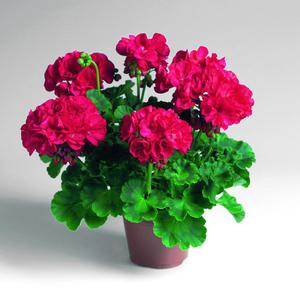 This flower variety is the most popular and also the most numerous species with a large number of varieties. All varieties of this geranium are quite resistant and are characterized by lush flowering.... Most often, all indoor geraniums of this variety have a straight trunk with rich refractory foliage and a brown or red edging. The leaves of this variety are pubescent, and at the same time they create a peculiar smell.
This flower variety is the most popular and also the most numerous species with a large number of varieties. All varieties of this geranium are quite resistant and are characterized by lush flowering.... Most often, all indoor geraniums of this variety have a straight trunk with rich refractory foliage and a brown or red edging. The leaves of this variety are pubescent, and at the same time they create a peculiar smell.
By the shape of the flowers, the zonal pelargoniums are:
- Terry - there are more than 8 petals on the flowers;
- Semi-double - on flowers up to 8 petals;
- Ordinary - have 5 petals.
The shape of the flowers of this variety is also different:
- Tulip, like flowers of closed tulips;
- Rosebuds, with pink or red buds, resembling not fully open roses in shape;
- Cactus with twisted and narrow petals, resembling a red chrysanthemum;
- Star-shaped, leaves and flowers repeat the shape of a star;
- Formosa, with flowers in the form of an asterisk and foliage dissected into 5 parts;
- Deacons, small flowers gathering in bouquets of purple, red and pink hues.
The colors of the petals are also distinguished by their variety. They can be multi-color, two-color or one-color, with or without border. Separately, flowers are distinguished, which are called "bird eggs", they have dark ovoid blotches with dotted dots and stripes. The flowering of this variety of pelargonium occurs throughout the summer, and if the plant is not placed in a dormant state in winter, then it can bloom all year round.
Zonal pelargoniums are also divided by height:
- Microminiature - up to 14 cm;
- Dwarf - 14-25 cm;
- Normal - 25–70 cm;
- Irene - up to 70 cm.
The name of this type of geranium is given by the color of the leaves, which have clearly marked areas, the central area and the edging have a different shade. The border can be red, white, blue and burgundy. The middle of the leaf can be very different, even black, silver or golden. There are varieties with tricolor foliage.
Royal Pelargonium
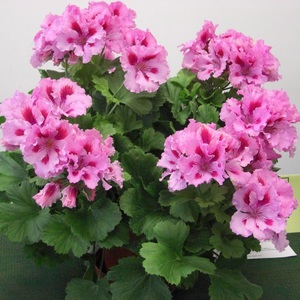 It is considered the most attractive plant of this variety. It has large flowers of various colors: pink, white, purple, burgundy and red. The diameter of the flowers can reach 16 cm and the same size in height.
It is considered the most attractive plant of this variety. It has large flowers of various colors: pink, white, purple, burgundy and red. The diameter of the flowers can reach 16 cm and the same size in height.
Hybrids of this plant began to appear in the 19th century, and royal geranium became the room favorite of gardeners around the world. Her large flowers, double or simple, have grooved or wavy petalswith stripes or a dark spot all the time, which is a characteristic feature of this variety. The two petals on top are larger and velvety than the others.
The plant can reach a height of up to 15 cm. If you look at the photo of the royal geranium, you can see that the rough and jagged leaves are very similar to maple leaves, and at the same time they are both monochromatic and bright.
This variety of pelargonium is the most whimsical flower of all geraniums, while the flowering time is much shorter than that of others (no more than 4 months), and occurs only after two years of growth.
Scented Pelargonium
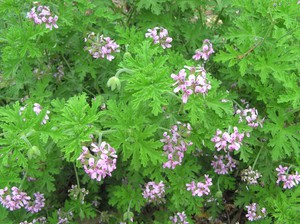 This variety of geranium has the most pleasant aromas, for this it got its name, as well as the recognition of gardeners. If you gently touch a leaf of a plant, you can immediately feel different strong aromas, among them you can feel lemon, rose, strawberry, ginger, mint.
This variety of geranium has the most pleasant aromas, for this it got its name, as well as the recognition of gardeners. If you gently touch a leaf of a plant, you can immediately feel different strong aromas, among them you can feel lemon, rose, strawberry, ginger, mint.
To date, hybrids have been bred that smell like apple, nutmeg, lilac, almond, pine, and even pineapple and kiwi.
The flowers of this indoor pelargonium are small and usually are purple or pinkas well as different shapes. Brightly cut foliage has 5-7 parts. In the photo you can see that the foliage of the fragrant geranium looks terry.
Using scented pelargonium
Geranium oil is extracted from this plant variety, which has a wide range of unique properties, and has a huge application in medicine, perfumery, cosmetology, and also in cooking. This oil is added to beverage syrups, jellies, and hard candies. A couple of drops of this oil removes the sometimes unpleasant smell of milk.
Leaves of this variety are added to teas, pies and fruit dishes... They are used to make aromatic sugars. For this, layers of sugar and leaves are placed in a glass container. The jar is exposed to the sun for 14 days. After the leaves are removed, and sugar is used directly to make various dishes.
Ivy-leaved pelargonium
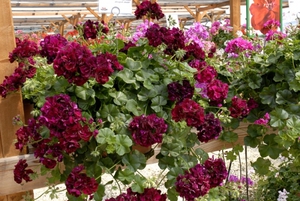 This variety of geranium is an ampelous species of herbaceous plants. The fragile and cascading shoots of this plant can be up to 1 m long. The shiny leaves of a rich green hue in the form of an asterisk resemble ivy, which gave the name to this flower.
This variety of geranium is an ampelous species of herbaceous plants. The fragile and cascading shoots of this plant can be up to 1 m long. The shiny leaves of a rich green hue in the form of an asterisk resemble ivy, which gave the name to this flower.
Flowers in a bud can be double, semi-double and simple up to 5 cm in size. Their color can vary from pure white to black and blue. Flowering takes place from early summer to late autumn.
Look great as a decor for loggias and balconies, especially when several species with different color of buds are planted in one hanging pot.
Pelargonium angel
This type of geranium is characterized by violet inflorescences that are similar to the Pansy flower. Plant up to 35 cm tall (with constant pruning) has a rather graceful shape, lush branching and unpretentious care... Flowering continues throughout the summer, flowers can be pink, white, purple, lilac with dark stripes or spots on the top two petals.
Pelargonium is unique
These flowers are more than one century old. The unique ones were obtained by crossing brilliant and royal varieties.The plant's dark green leaves are heavily dissected and have a slight spicy scent. Flowers are very similar to royal geranium, but slightly smaller. As a rule, they have a white center and red leaf color. Pink and white varieties are few in number. Some species have dark streaks and spots.
Succulent pelargonium
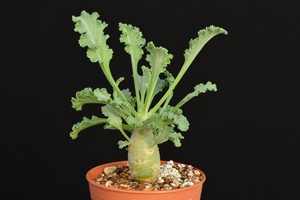 This is a rather unusual variety of geranium. The lignified plant stems from below are strongly curved and branched. With increased dryness of the air and weak watering, the bush sheds leaves. The plant has rather bizarre shapes that resemble various fantastic creatures. The branches sometimes have thorns. This flower is usually chosen for bonsai decoration., and as exotic plants for room decoration. Of the 10 varieties of this plant, as a rule, you can find cortusoliferous, humpbacked, fluffy, fleshy, angular and thick-stemmed geraniums.
This is a rather unusual variety of geranium. The lignified plant stems from below are strongly curved and branched. With increased dryness of the air and weak watering, the bush sheds leaves. The plant has rather bizarre shapes that resemble various fantastic creatures. The branches sometimes have thorns. This flower is usually chosen for bonsai decoration., and as exotic plants for room decoration. Of the 10 varieties of this plant, as a rule, you can find cortusoliferous, humpbacked, fluffy, fleshy, angular and thick-stemmed geraniums.
Lemon Pelargonium
This variety of geranium has earned its popularity due to its strongly dissected, pubescent, bright green leaves of a complex shape. The bush is quite tall, it can grow up to 1.5 meters. When the leaves are touched, it emits a strong lemon scent.
The healing properties of geranium
For the unique healing properties of many types of geraniums, Bulgarians call it "health resort". And in fact, it works great for many diseases:
- Toothache goes away if you hold the geranium in your mouth for a short time;
- Inflammation and a feeling of pain with otitis media can be removed with crushed leaves of fragrant pelargonium, if they are laid in the ear canal;
- Geranium infusion is excellent for stress and neurosis, and also treats gout and colds;
- Geranium sheet attached to the wrist stabilizes pressure;
- For itching, wounds, swelling and eczema, use leaf baths;
- The scent of this flower eliminates irritability, insomnia and headache;
- The plant also helps pets in the treatment of ear mites;
- Decoctions of roots and leaves are used for kidney disease, salt deposition and diabetes.
Pelargonium oil properties
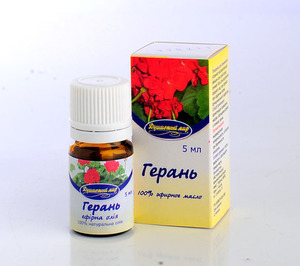 Speaking of pelargonium, one cannot fail to mention the essential oil, which is made from this plant. Today, neither the cosmetic, nor the perfumery, nor the confectionery, nor the soap industry can do without its use. Also, without this oil, coloring and dressing of certain types of leather is impossible.
Speaking of pelargonium, one cannot fail to mention the essential oil, which is made from this plant. Today, neither the cosmetic, nor the perfumery, nor the confectionery, nor the soap industry can do without its use. Also, without this oil, coloring and dressing of certain types of leather is impossible.
In folk medicine, a couple of drops of oil diluted in a glass of water are used to treat ulcers, urinary tract infections, diarrhea, diabetes, and bleeding.
Also, this oil is an anthelmintic substance. Oil baths are used for eczema, burns, high pressure and headaches.
But do not forget that, like all traditional methods of treatment, the use of geranium has some contraindications, while it cannot replace drug therapy. Therefore, before starting treatment with its help, it is imperative to consult a doctor.
Geranium perfectly cleans the air, removes unpleasant odors (for example, fumes). At the same time, it fights well against moths, flies and mosquitoes.
Signs associated with geranium
This flower is considered a talisman that protects the house from many troubles and does not allow people with bad intentions to enter it. The plant has a positive energy, therefore, many superstitions and omens associated with it have a positive direction.
If there is this flower in the house, then households almost never suffer from stress and do not quarrel... According to ancient beliefs, geranium oil protects from evil eyes, dark forces and other evil spirits. And the girls carried small bags of geraniums with them to attract suitors. And they helped older ladies to maintain their youth and attractiveness.
Blooming white geranium was a sign of addition to the family, therefore there is a custom to give it to couples who cannot have children for a long time. At the same time, white geranium still protects against ruin and disasters.
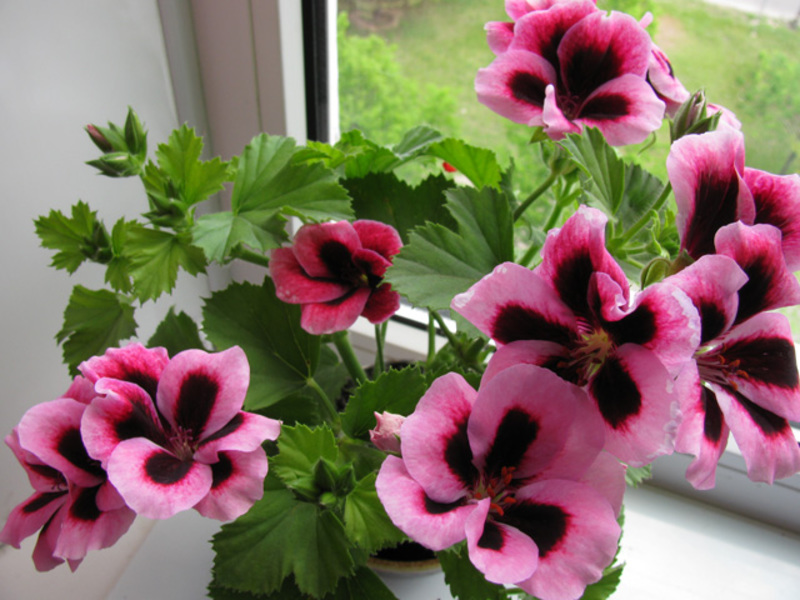

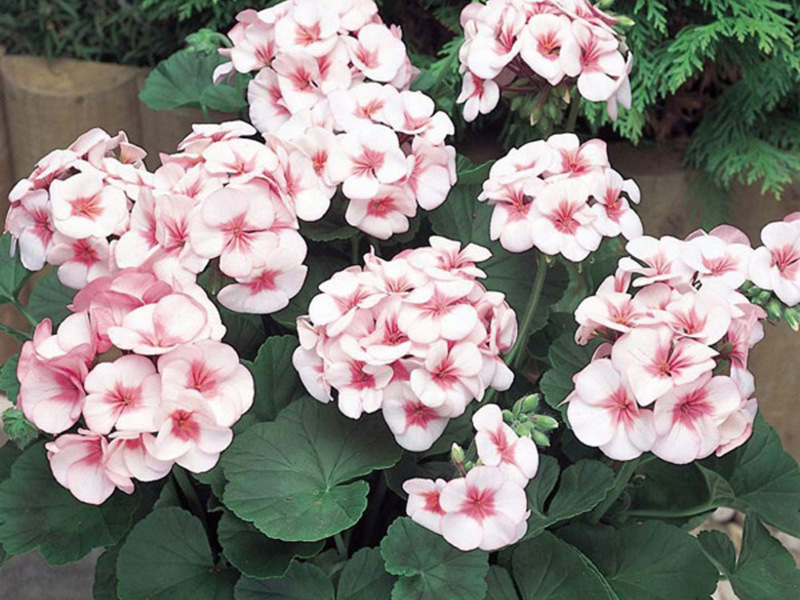
But red geranium is useful for those couples who always conflict with each other. This flower brings calmness to the house and removes all negative emotions.
A significant role in the pink geranium... She can revive the extinct feelings of the spouses over a long time of life together. She brings emotions, passion and ardor back to relationships. It is also used against witchcraft. Since it is a flower of delight, it is advised to keep it in houses where creative individuals live.
Also there is a belief that geranium, especially red, helps its owners to properly manage moneythat accompanies material well-being. And if you install it near the azalea pot, then the influx of money cannot be avoided.
Astrologers say indoor geranium can quickly extinguish rage and anger, neutralize negative energy in rooms, develop a sense of humor and relax nerves.
In places where geraniums are found, snakes are never found.
If this plant, in fact, has at least part of the prescribed properties, then the question of whether it is possible to plant geranium at home disappears by itself, installing it on your windowsill, it will probably be possible to decorate your home, as well as get rid of many problems in the family and home ...
